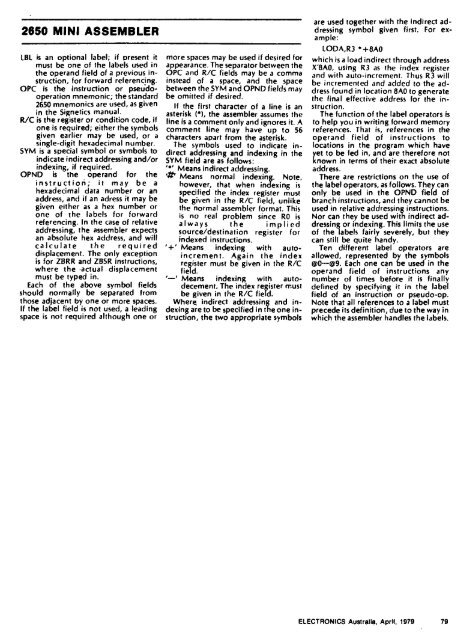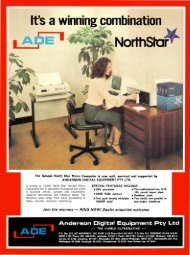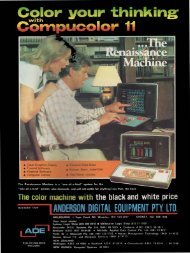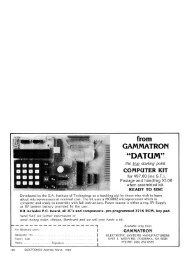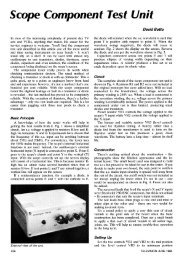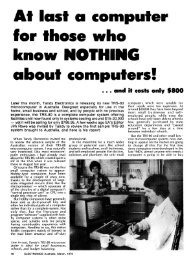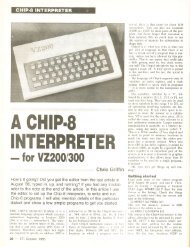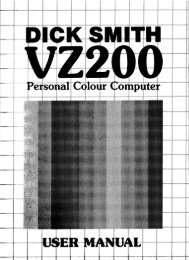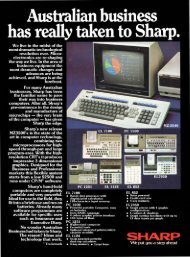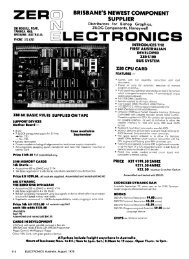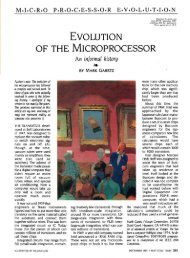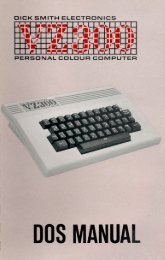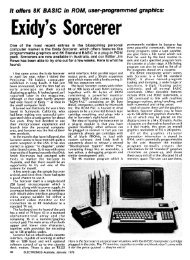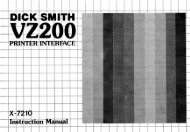The Signetics 2650 - The MESSUI Place
The Signetics 2650 - The MESSUI Place
The Signetics 2650 - The MESSUI Place
Create successful ePaper yourself
Turn your PDF publications into a flip-book with our unique Google optimized e-Paper software.
<strong>2650</strong> MINI ASSEMBLER<br />
LBL is an optional label; if present it<br />
must be one of the labels used in<br />
the operand field of a previous instruction,<br />
for forward referencing.<br />
OPC is the instruction or pseudooperation<br />
mnemonic; the standard<br />
<strong>2650</strong> mnemonics are used, as given<br />
in the <strong>Signetics</strong> manual.<br />
R/C is the register or condition code, if<br />
one is required; either the symbols<br />
given earlier may be used, or a<br />
single-digit hexadecimal number.<br />
SYM is a special symbol or symbols to<br />
indicate indirect addressing and/or<br />
indexing, if required.<br />
OPND is the operand for the<br />
instruction; it may be a<br />
hexadecimal data number or an<br />
address, and if an adress it may be<br />
given either as a hex number or<br />
one of the labels for forward<br />
referencing. In the case of relative<br />
addressing, the assembler expects<br />
an absolute hex address, and will<br />
calculate the required<br />
displacement. <strong>The</strong> only exception<br />
is for ZBRR and ZBSR instructions,<br />
where the -actual displacement<br />
must be typed in.<br />
Each of the above symbol fields<br />
should normally be separated from<br />
those adjacent by one or more spaces.<br />
If the label field is not used, a leading<br />
space is not required although one or<br />
more spaces may be used if desired for<br />
appearance. <strong>The</strong> separator between the<br />
OPC and R/C fields may be a comma<br />
instead of a space, and the space<br />
between the SYM and OPND fields may<br />
be omitted if desired.<br />
If the first character of a line is an<br />
asterisk (*), the assembler assumes the<br />
line is a comment only and ignores it. A<br />
comment line may have up to 56<br />
characters apart from the asterisk.<br />
<strong>The</strong> symbols used to indicate indirect<br />
addressing and indexing in the<br />
SYM field are as follows:<br />
Means indirect addressing.<br />
'#' Means normal indexing. Note,<br />
however, that when indexing is<br />
specified the index register must<br />
be given in the R/C field, unlike<br />
the normal assembler format. This<br />
is no real problem since RO is<br />
always the implied<br />
source/destination register for<br />
indexed instructions.<br />
'+' Means indexing with autoincrement.<br />
Again the index<br />
register must be given in the R/C<br />
field.<br />
—' Means indexing with autodecement.<br />
<strong>The</strong> index register must<br />
be given in the R/C field.<br />
Where, indirect addressing and indexing<br />
are to be specified in the one instruction,<br />
the two appropriate symbols<br />
are used together with the indirect addressing<br />
symbol given first. For example:<br />
LODA,R3 • -1-8A0<br />
which is a load indirect through address<br />
X'8A0, using R3 as the index register<br />
and with auto-increment. Thus R3 will<br />
be incremented and added to the address<br />
found in location 8A0 to generate<br />
the final effective address for the instruction.<br />
<strong>The</strong> function of the label operators is<br />
to help you in writing forward memory<br />
references. That is, references in the<br />
operand field of instructions to<br />
locations in the program which have<br />
yet to be fed in, and are therefore not<br />
known in terms of their exact absolute<br />
address.<br />
<strong>The</strong>re are restrictions on the use of<br />
the label operators, as follows. <strong>The</strong>y can<br />
only be used in the OPND field of<br />
branch instructions, and they cannot be<br />
used in relative addressing instructions.<br />
Nor can they be used with indirect addressing<br />
or indexing. This limits the use<br />
of the labels fairly severely, but they<br />
can still be quite handy.<br />
Ten different label operators are<br />
allowed, represented by the symbols<br />
*0—©9. Each one can be used in the<br />
operand field of instructions any<br />
number of times before it is finally<br />
defined by specifying it in the label<br />
field of an instruction or pseudo-op.<br />
Note that all references to a label must<br />
precede its definition, due to the way in<br />
which the assembler handles the labels.<br />
ELECTRONICS Australia. April, 1979 79


